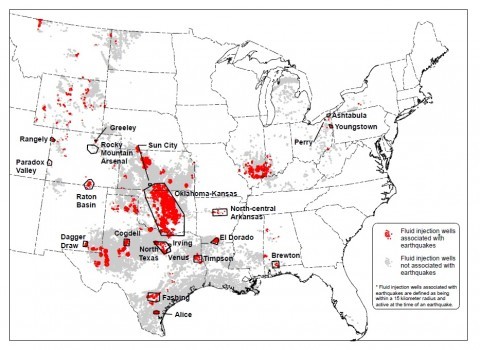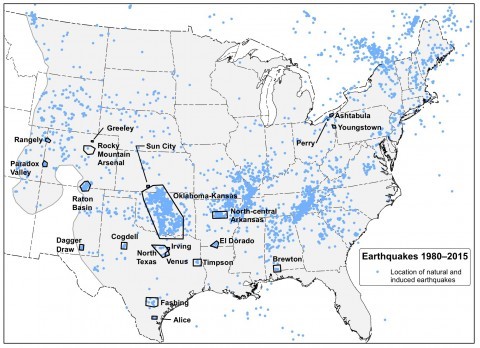28 March 2016, USGS: 2016 One-Year Seismic Hazard Forecast for the Central and Eastern United States from Induced and Natural Earthquakes (PDF)
7 million Americans at risk of man-made earthquakes, USGS says
By Joel Achenbach
March 28, 2016
Earthquakes are a natural hazard -- except when they're man-made. The oil and gas industry has aggressively adopted the technique known as hydraulic fracturing, or fracking, to shatter subsurface shale rock and liberate the oil and gas lurking there. But the process results in tremendous amounts of chemical-laden wastewater. Horizontal drilling for oil can also produce massive amount of natural, unwanted salt water. The industry disposes of this wastewater by pumping it into deep wells.
And the Earth moves.
On Monday, the U.S. Geological Survey published for the first time [1] an earthquake hazard map covering both natural and "induced" quakes. The map and an accompanying report indicate that parts of the central United States now face a ground-shaking hazard equal to the famously unstable terrain of California.
Some 7 million people live in places vulnerable to these induced tremors, the USGS concluded. The list of places at highest risk of man-made earthquakes includes Oklahoma, Kansas, Texas, Arkansas, Colorado, New Mexico, Ohio and Alabama. Most of these earthquakes are relatively small, in the range of magnitude 3, but some have been more powerful, including a magnitude 5.6 earthquake in 2011 in Oklahoma that was linked to wastewater injection.
Scientists said Monday they do not know if there is an upper limit on the magnitude of induced earthquakes; this is an area of active research. Oklahoma has had prehistoric earthquakes as powerful as magnitude 7.
It's not immediately clear whether this new research will change industry practices, or even whether it will surprise anyone in the areas of newly estimated risk. In Oklahoma, for example, the natural rate of earthquakes is only one or two a year, but there have been hundreds since fracking and horizontal drilling, with the associated wastewater injection, became commonplace in the last decade.
"By including human-induced events, our assessment of earthquake hazards has significantly increased in parts of the U.S.,” Mark Petersen, chief of the USGS National Seismic Hazard Mapping Project, said in a release.
The report, based on recent seismic activity, is just a one-year hazard assessment. In effect, the scientists have said that what has happened in the recent past with induced earthquakes will likely happen in the near future.
Past USGS hazard maps didn't include man-made events. The 2014 USGS seismic hazard map showed negligible risk of natural earthquakes in the Dallas-Fort Worth area, for example. But the new map, with the induced shaking added, boosts the risk there by a factor of 10, the USGS determined.
A fault running between Dallas and the adjacent city of Irving caused a magnitude 3.6 earthquake in January 2015. An injection well is only about six miles away. Researchers are actively studying that 2015 tremor, said Heather R. DeShon, a seismologist at Southern Methodist University.
“The new map serves as a reminder to the local populations living with the recent earthquakes that it is best to be prepared to feel ground shaking," said DeShon, who was not involved in the new study.
The Dallas Morning News reported [2] that an unreleased study by the Federal Emergency Management Agency estimated that a worst-case, 5.6 magnitude earthquake hitting Dallas could damage 80,000 buildings, cause levees to collapse and lead to $9.5 billion in economic losses.
The most dramatic feature on the new USGS map is the dark red blob in north-central Oklahoma, which has already had a magnitude 5.1 earthquake this year.
"My first thought was actually holy crap, Oklahoma is redder than California," USGS geologist Susan Hough said in an email to The Post after she saw her agency's map Monday for the first time.
The earthquake hazard is hard to estimate in any given moment and in any given place, in part because natural earthquakes are inherently unpredictable. The oil and gas industry is unpredictable, too. With oil prices low, companies have cut back on drilling recently.
The cut-back in production may be one explanation for a decline in recent months in earthquakes in southern Kansas, said Rex Buchanan, director of the Kansas Geological Survey. Another factor may be new state regulations governing the wastewater disposal wells, he said.
With a few exceptions, locations in the nation's central and eastern regions are not generally thought of as seismically active. But that doesn't mean there aren't faults underlying those calmer regions. “Pretty much everywhere has faults. The nation was built over a billion years, and lots and lots of faults are left over from the construction process," Michael Blanpied, associate coordinator of the USGS Earthquake Hazards Program, told The Post.
The fluids injected into the deep wells don't lubricate the faults so much as put additional pressure on them, driving their walls apart, he noted.

U.S. Geological Survey map shows the potential for Americans to experience damage from natural or human-induced earthquakes in 2016. Changes range from less than 1 percent to 12 percent. (Courtesy of USGS)

USGS map displaying 21 areas impacted by induced earthquakes as well as the location of the fluid injection wells that have and have not been associated with earthquakes. (Courtesy of USGS)

USGS map displaying 21 areas where scientists have observed rapid changes in seismicity that have been associated with wastewater injection. The map also shows earthquakes - both natural and induced - recorded from 1980 to 2015 in the central and eastern U.S. with a magnitude greater than or equal to 2.5. (Courtesy of USGS)